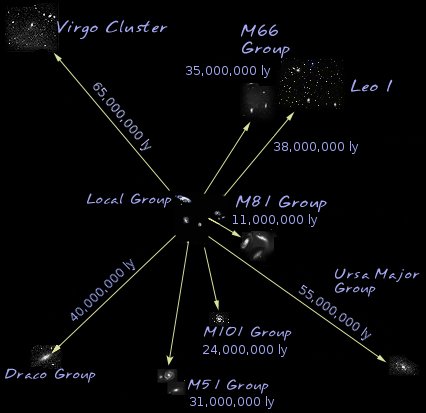
View larger. | Artist’s concept showing our Milky Way galaxy, its satellite galaxies, and other galaxies in our Local Group. The Milky Way isn’t really the center of anything; that’s just the way the image is drawn. The 3 largest galaxies in the Local Group are, in descending order, the Andromeda galaxy, the Milky Way, and M33 also known as the Triangulum Galaxy. Image via Wikimedia Commons.
We know where our galaxy is located, but only locally speaking. The Milky Way galaxy is one of more than 54 galaxies known as the Local Group. The three largest members of the group are our Milky Way (second-biggest), the Andromeda galaxy (biggest) and the Triangulum Galaxy. The other galaxies in the Local Group are dwarf galaxies, and they’re mostly clustered around the three larger galaxies.
The illustration above is a bit misleading because it suggests our Milky Way galaxy lies at the center of the Local Group. It doesn’t, of course, but the image is organized that way, presumably to honor our human perspective.
On the other hand, the Local Group does have a gravitational center. It’s somewhere between the Milky Way and the Andromeda Galaxy.
The Local Group has a diameter of about 10 million light-years.
Astronomers have also discovered that our Local Group is on the outskirts of a giant supercluster of galaxies, known as the Virgo Supercluster.

Distances from the Local Group for selected groups and clusters within our local supercluster, called the Virgo Supercluster. Image via Wikimedia Commons.
Another artist’s concept of the Virgo Supercluster, via Wikimedia Commons.
At least 100 galaxy groups and clusters are located within the Virgo Supercluster. Its diameter is thought to be about 110 million light-years.
The Virgo Supercluster may be part of an even-larger structure that astronomers call the Laniakea Supercluster. It consists of perhaps 100,000 galaxies stretched out over some 520 million light-years.
The Laniakea Supercluster is one of many such vast structures in space, known to astronomers at this time.
Map of superclusters within the nearby universe, with Laniakea shown in yellow. Image via Wikimedia Commons.
Bottom line: A word about our Milky Way galaxy within the Local Group, and beyond.
from EarthSky https://ift.tt/2QzuICw

View larger. | Artist’s concept showing our Milky Way galaxy, its satellite galaxies, and other galaxies in our Local Group. The Milky Way isn’t really the center of anything; that’s just the way the image is drawn. The 3 largest galaxies in the Local Group are, in descending order, the Andromeda galaxy, the Milky Way, and M33 also known as the Triangulum Galaxy. Image via Wikimedia Commons.
We know where our galaxy is located, but only locally speaking. The Milky Way galaxy is one of more than 54 galaxies known as the Local Group. The three largest members of the group are our Milky Way (second-biggest), the Andromeda galaxy (biggest) and the Triangulum Galaxy. The other galaxies in the Local Group are dwarf galaxies, and they’re mostly clustered around the three larger galaxies.
The illustration above is a bit misleading because it suggests our Milky Way galaxy lies at the center of the Local Group. It doesn’t, of course, but the image is organized that way, presumably to honor our human perspective.
On the other hand, the Local Group does have a gravitational center. It’s somewhere between the Milky Way and the Andromeda Galaxy.
The Local Group has a diameter of about 10 million light-years.
Astronomers have also discovered that our Local Group is on the outskirts of a giant supercluster of galaxies, known as the Virgo Supercluster.

Distances from the Local Group for selected groups and clusters within our local supercluster, called the Virgo Supercluster. Image via Wikimedia Commons.
Another artist’s concept of the Virgo Supercluster, via Wikimedia Commons.
At least 100 galaxy groups and clusters are located within the Virgo Supercluster. Its diameter is thought to be about 110 million light-years.
The Virgo Supercluster may be part of an even-larger structure that astronomers call the Laniakea Supercluster. It consists of perhaps 100,000 galaxies stretched out over some 520 million light-years.
The Laniakea Supercluster is one of many such vast structures in space, known to astronomers at this time.
Map of superclusters within the nearby universe, with Laniakea shown in yellow. Image via Wikimedia Commons.
Bottom line: A word about our Milky Way galaxy within the Local Group, and beyond.
from EarthSky https://ift.tt/2QzuICw

Aucun commentaire:
Enregistrer un commentaire